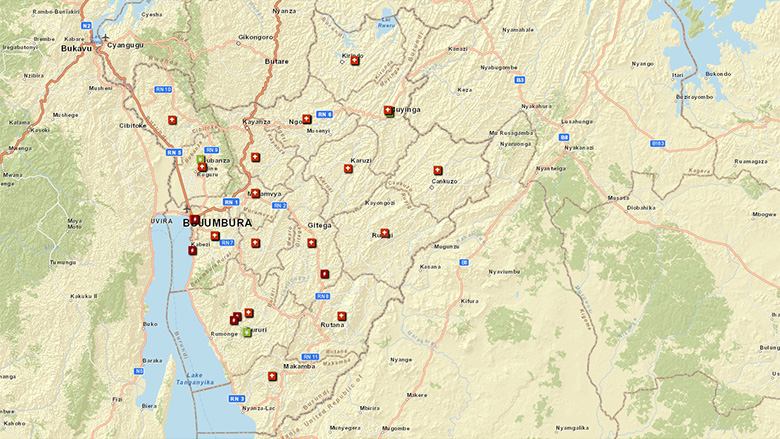Challenge
In 2001, Burundi was a poor country reeling from the effects of acute civil and ethnic conflict in the 1990s that continued into the new millennium. Per capita gross domestic product (GDP) was the second lowest in the world at US$100, with 91 percent of the population dependent on agriculture and living in rural areas. A conflict-induced economic collapse fueled by the destruction of farm capital goods and livestock, as well as a discontinuation of social services, pushed the post-conflict poverty rate to 58 percent by 2003. Though agriculture accounted for 50 percent of GDP and 80 percent of export earnings, agriculture research, extension, fertilizer use, and access to finance were all very low, which kept productivity similarly depressed. The stress of the conflict and daily needs of internally displaced persons (IDPs) also led to deforestation, watershed degradation, and soil erosion, which in turn exposed the lack of government capacity in environmental stewardship and rural development.
Solution
The aim of this project was therefore to address the above challenge by: restoring the productive capacity of rural areas through investments in production and sustainable land management, as well as by building capacity for producer organizations and local communities while targeting war-distressed returnees and internally displaced persons (IDPs). The project invested in community-driven agriculture, financed sustainable land and water management activities, and provided returnees and IDPs emergency support for productive activity, all of which helped to restore the productive capacity of rural areas. Capacity building support was provided to producer and community-based organizations, Local Implementing Agencies, and the Ministries of Agriculture and Livestock and of Water, Environment, and Natural Resource Management. Finally, ministry workspace, vehicles, and equipment were financed, and ministerial communication activities were supported. In order to facilitate wider adoption of sustainable land use management practices, the project provided support for the Burundi Institute of Agronomic Science.
Results
By 2011, at closing, the project saw the following results:
- Over 80 percent of returning refugees and displaced families that received project-financed kits have returned to normal agricultural life.
- 40,000 households, home to 216,000 people, are in position to restart their agricultural activities.
- Of the 3,750 total subprojects being implemented, 45 percent belong to women.
- 3,124 hectares of watershed are now being sustainably managed.
- 28,744 hectares of community forest have been established.
- About 71.5 million trees have been introduced to the farming systems.
- Eight provincial land use plans have been completed.
From 2004 to 2011, production increased in the following commodities:
- Milk from 2.5 L/cow/day to 6 L/cow/day.
- Irrigated rice from 2.5 tons/ha to 4.5 tons/ha.
- Cassava from 6 tons/ha to 10 tons/ha.
- Onion from 4 tons/ha to 12 tons/ha.
Bank Group Contribution
There were three components of the project as originally conceptualized. The largest component was the support for production and sustainable land management investments, to which the International Development Association (IDA) and the Global Environment Fund (GEF) contributed a total of $38.17 million. The next component was the support for capacity building and institutional strengthening, to which IDA and GEF contributed a total of $10.92 million. The final and smallest component was the support for project coordination and management to which IDA and GEF contributed $5.91 million.
Partners
The GEF operational program played a key role in addressing the causes of land degradation by accelerating locally driven sustainable land management practices, contributing to the maintenance of ecosystem services, and the preservation of their structures. The GEF also played a crucial role in financing and executing the project.
Moving Forward
In order to prevent a gap in IDA support for Burundi’s rural development, IDA prepared a second operation, Agro-pastoral and Markets Development Project (PRODEMA) to pick up where this project left off. This project helped inform the direction of PRODEMA, particularly in its successful use of grassroots organizations and matching grants for community-driven development, as well as channeling resources through Local Implementing Agencies. PRODEMA will continue to build basic institutional capacity in Burundi, support irrigation schemes, and work to consolidate sustainably the successes of this project.
Beneficiaries
N/A

